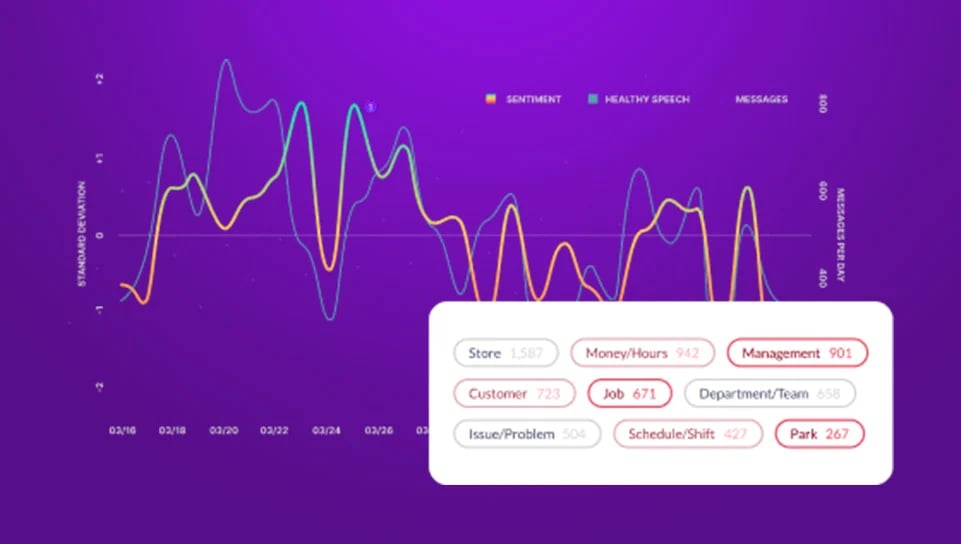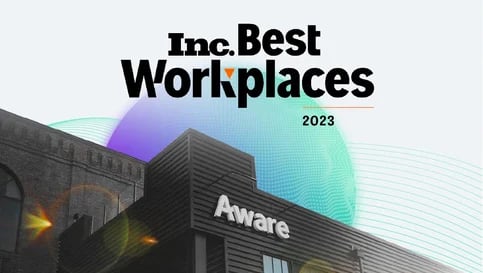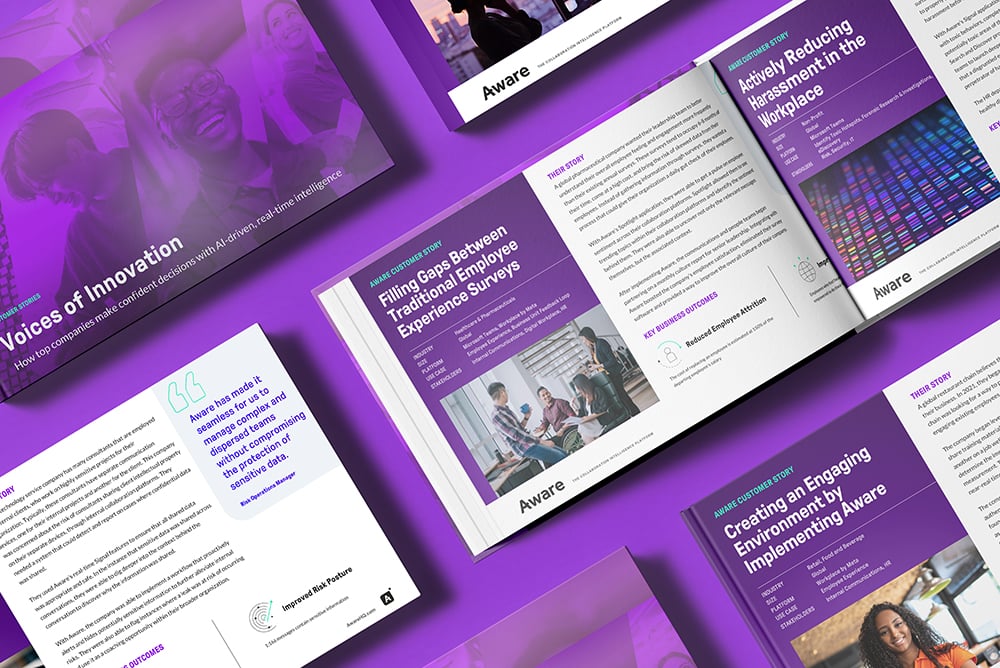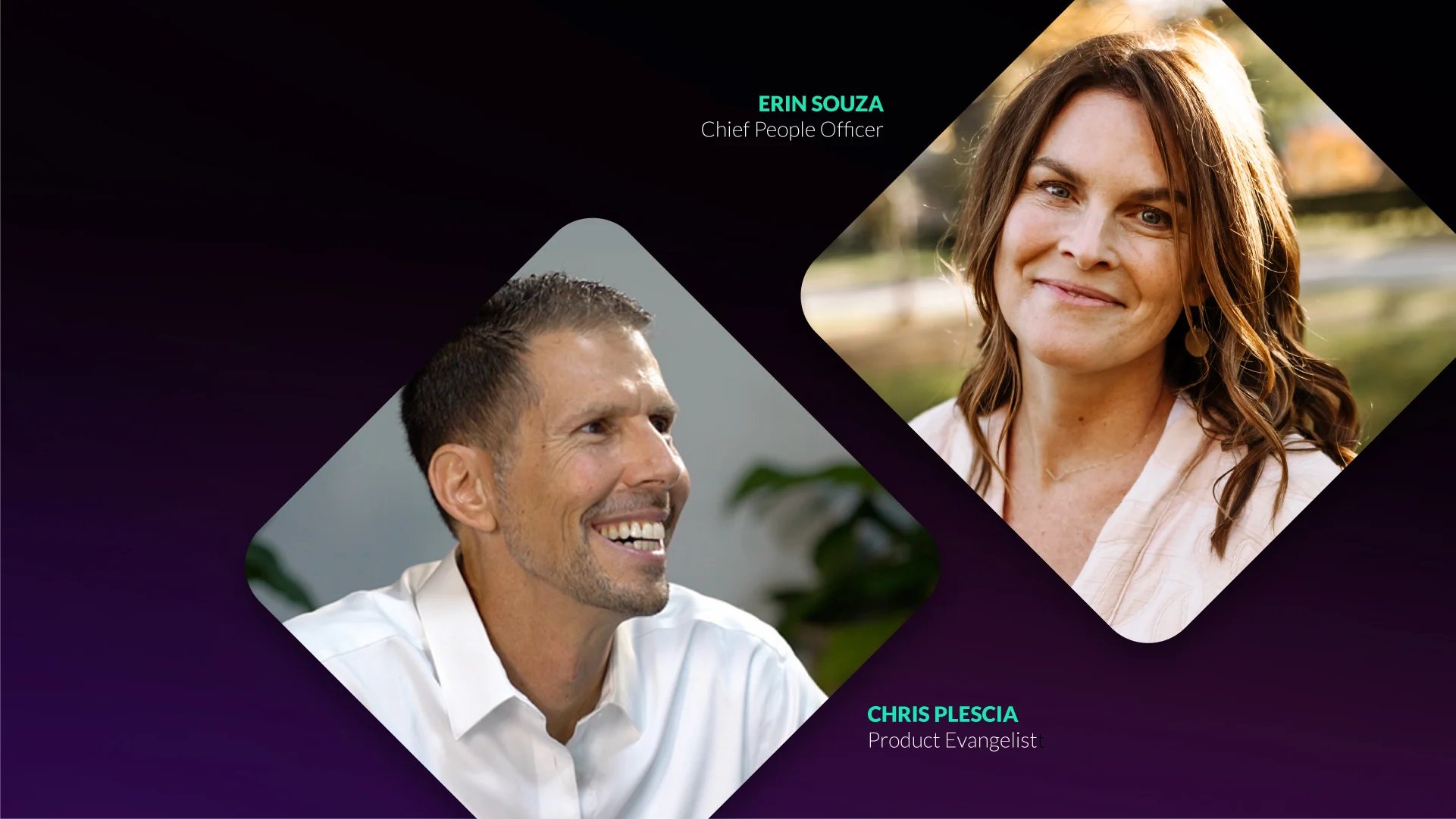AWARE FOR IDENTIFYING TOXIC HOT SPOTS
Stop toxicity in its tracks
Proactively protect your employees and your company culture
Capture authentic behavioral signals from employee voices at scale to automatically identify toxic hot spots and take swift, decisive action to protect your company culture.
Spot issues immediately
Automated sentiment analysis takes the guesswork out of detecting toxicity with real-time feedback on how the mood of your organization shifts.
Improve employee experience
Build and maintain a strong company culture by encouraging the behavior you want to see and shielding your people from toxic coworkers.
Protect the bottom line
Eliminating toxicity creates happy employees and cohesive teams that are more productive, provide better customer service, and help the company to innovate.
What can you do with Aware?
Surface toxic behaviors in real time without having to search
Take the guesswork out of managing your people with automated sentiment analysis normalized for your company that tells you what’s happening within your organization in real time.
Understand and address the subjects that trigger toxicity
Get deeper insight into the topics that trigger toxicity within your workplace to understand how to position top-down messaging that supports and defends your company culture.
Mitigate the risk of malicious actors and insider threats
Toxic employees can quickly become insider threat actors. Improve your risk posture by addressing toxic behaviors before they become a serious security risk for your enterprise.
Industry-leading sentiment analysis designed for collaboration
Proactively support and reinforce a positive company culture with industry-leading natural language processing (NLP) capabilities, backed by the latest AI/ML-infused insights, designed for the nuances of collaboration tools like Slack, Teams, and Zoom.
Signal
Enforce acceptable use policies with automated workflows that detect unwanted behaviors and coach employees in real time.
- Customize workflows and define outcomes to suit your org
- Protect your company 24/7 from costly fines and penalties
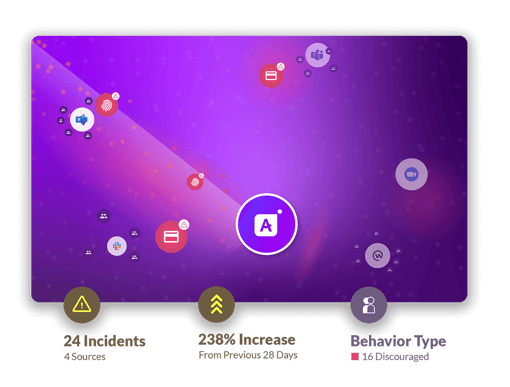
Spotlight
Visualize how topics and conversations fluctuate through your collaboration environment and uncover the subjects that matter most to your people.
- Organically surface the areas where toxicity is highest
- Identify pockets of positivity and company champions
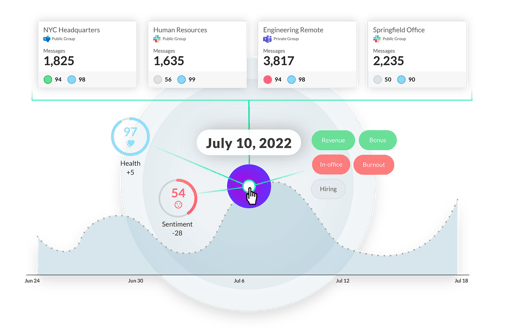
RESOURCES
Learn more about protecting your business from the risks of collaboration.

Whitepaper
The Human Behavior Risk Analysis
Learn more about the challenges that live in collaboration datasets, and how prevalent negativity and toxicity really are.
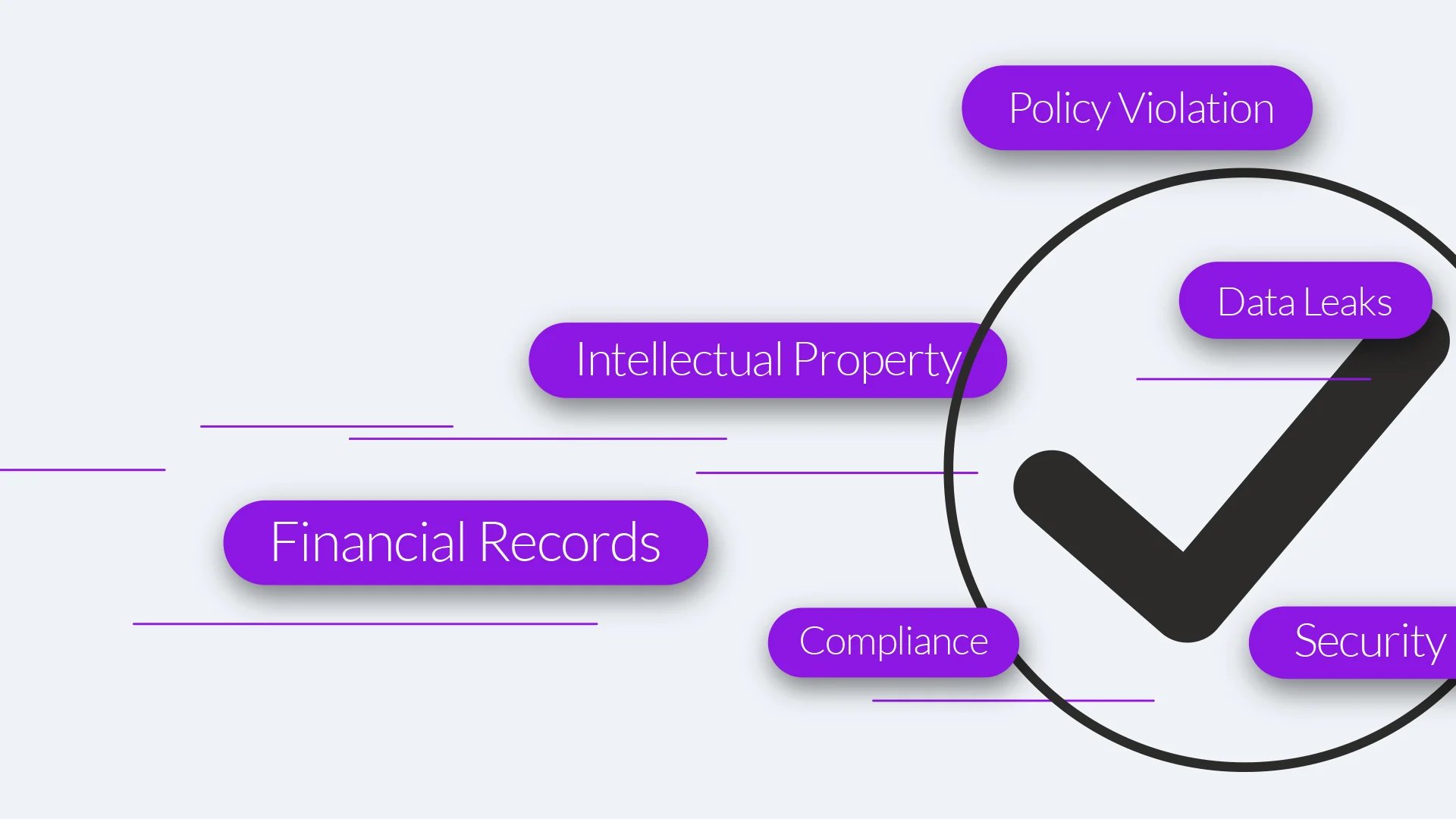
checklist
A Quick Checklist for Collaboration Security
Take charge of tools like Slack, Teams, and Zoom with a comprehensive checklist that helps you cover the bases and protect your organization.
Frequently asked questions
What is a toxic employee? How is toxicity different to everyday negativity?
A toxic employee is someone who consistently displays behavior that is harmful, disruptive, or negative to their colleagues, workplace culture, or company goals. This can include things like bullying, harassment, unproductive communication, or unethical conduct.
Negative employees can have a harmful impact on morale and productivity, but that is a side effect of their negative behavior. In contrast, toxicity goes beyond negativity to include behavior that is actively harmful or disruptive, such as bullying, harassment, or unprofessional conduct. Toxic employees can create a hostile work environment and may even drive away other employees, while negative employees may simply bring down the overall mood or energy of the workplace.
What damage can a disgruntled employee do to an organization?
A toxic or disgruntled employee often seeks to harm the organization or their coworkers. They may engage in sabotage, theft, or vandalism, which can result in financial losses or damage to property. They may also spread negative rumors or engage in public criticism of the company, which can harm the organization's reputation and reduce customer trust. In addition, a disgruntled employee can create a toxic work environment that can lower morale, decrease productivity, and even drive away other employees. Finally, they may file frivolous lawsuits or make baseless complaints against the organization, which can result in legal fees, damage to the company's reputation, and other negative consequences.
Are toxic employees a type of insider threat?
Yes, toxic employees can be considered a type of insider threat to an organization. Insider threats refer to any individual with authorized access to an organization's systems, facilities, or data who uses that access to intentionally or unintentionally cause harm to the organization. As such, it is important for organizations to identify and address toxic behavior among employees, just as they would other types of insider threats.
How does Aware detect toxic employees in collaboration tools?
Aware uses industry-leading, proprietary natural language processing (NLP) and AI-infused sentiment scoring to evaluate messages from collaboration tools in real time for negative, offensive, and toxic speech. Aware’s artificial intelligence and machine learning models are trained on each specific organization, meaning they learn and understand what “normal” looks like for that environment. This gives leaders more accurate oversight and better understanding of how and when the mood shifts within their organization.
How can employee listening strategies counteract toxic employees?
By regularly listening to employees and encouraging open communication, employers can identify potential issues or conflicts early on and take steps to address them before they escalate. This can help prevent toxic behavior from spreading or becoming entrenched in the workplace. Actively listening to concerns and taking steps to address them helps foster a more positive and supportive work environment, which can reduce the likelihood of toxic behavior. Aware enables advanced employee listening by surfacing the topics of greatest concern without employers needing to ask.
Why is it important to address toxic employees and protect company culture?
Unmanaged, toxic employees can have a negative impact on the workplace environment and culture, harming productivity, retention, and even the organization’s reputation. Aware research shows that toxicity is contagious, and just one toxic employee can have a detrimental effect on company culture, creating a toxic environment that can be difficult to change. Toxic behavior can also lead to legal and compliance issues, including harassment and discrimination claims. Failing to address this behavior at source can create liability risks for the organization, including reputational damage, loss of customers, and legal fees. That’s why it is essential for businesses to proactively defend their company culture and create a positive workplace for all employees.
Why is employee experience important?
Employee experience has a significant impact on employee satisfaction, engagement, and productivity, as well as the overall success of the organization. When employees have a positive experience at work, they are more likely to be motivated, committed, and invested in the success of the organization. This can lead to higher levels of engagement and productivity, as well as lower rates of absenteeism and turnover. Additionally, a positive employee experience can help attract and retain top talent and enhance the organization's reputation as an employer.
How does Aware support a better employee experience?
Aware gives innovative leaders a direct line from their front line, visualizing shifts in sentiment and surfacing the topics that matter most to employees. Using these insights, businesses can make faster decisions with greater certainty, based on a real-time understanding of what is happening at every level of the organization. Without Aware, it can take months before the impact of a toxic employee is felt by management, and by that point the damage to company culture may be difficult to reverse. Aware turns a spotlight onto toxic behavior, enabling proactive resolution before it becomes a widespread problem.
What impact does employee experience have on employee retention rates?
Positive employee experiences increase job satisfaction and create a sense of loyalty, engagement, and commitment to the organization that increases employee retention. Toxic working environments contribute to negative employee experiences, which increase the likelihood of demotivation and disengagement, leading to high turnover and low employee retention. Because it can take six months or more and cost a third of an employee’s annual salary to replace them, high employee retention rates are an important goal of human resource managers. Investing in a positive employee experience by proactively tackling toxicity at source is an essential part of any employee retention strategy.
What other use cases does Aware support in addition to toxic hot spot detection?
Aware collaboration intelligence platform solves for a wide range of security, governance, compliance, and people management use cases across leading collaboration tools like Slack, Teams, and Zoom. Some of the primary use cases Aware supports include: data loss prevention (DLP), insider risk detection, forensics and investigations, compliance adherence, eDiscovery, employee experience, information governance, business feedback loops and key initiative tracking.





